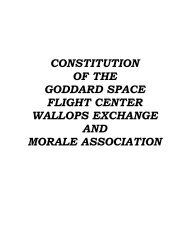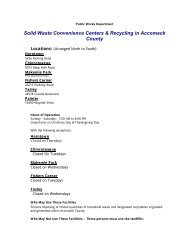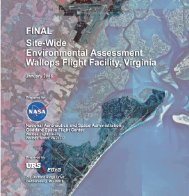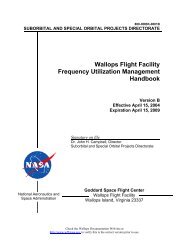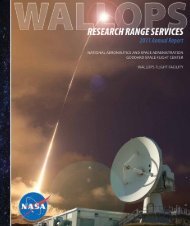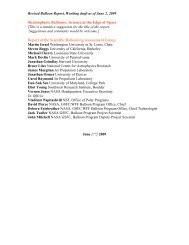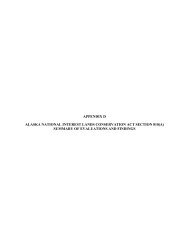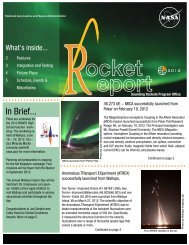Alternative Energy Draft EA - NASA Visitor Center at Wallops Flight ...
Alternative Energy Draft EA - NASA Visitor Center at Wallops Flight ...
Alternative Energy Draft EA - NASA Visitor Center at Wallops Flight ...
Create successful ePaper yourself
Turn your PDF publications into a flip-book with our unique Google optimized e-Paper software.
Affected Environment<br />
To estim<strong>at</strong>e how many birds were likely killed <strong>at</strong> the existing towers, the numbers of carcasses<br />
found were multiplied by a factor of four. This factor includes a general searcher efficiency r<strong>at</strong>e<br />
of 50 percent and a carcass removal r<strong>at</strong>e of 50 percent. The factor is calcul<strong>at</strong>ed by multiplying<br />
0.5 by 0.5 for a combined r<strong>at</strong>e of 0.25, the factor of four used to calcul<strong>at</strong>e f<strong>at</strong>ality r<strong>at</strong>e. Studies of<br />
bird carcasses <strong>at</strong> communic<strong>at</strong>ion towers indic<strong>at</strong>e th<strong>at</strong> the factor of four is likely to reflect<br />
searcher efficiency and carcass removal <strong>at</strong> a wide variety of habit<strong>at</strong>s bene<strong>at</strong>h communic<strong>at</strong>ion<br />
towers (Gehring et al., 2009).<br />
Findings<br />
The following is a summary of the d<strong>at</strong>a collected during the avian surveys described above;<br />
detailed results are presented in the Avian Study Final Report (Appendix A). Although the<br />
surveys officially started on October 1, 2008, some d<strong>at</strong>a collected prior to this d<strong>at</strong>e are included<br />
in the report, particularly diurnal point count observ<strong>at</strong>ions th<strong>at</strong> began on September 12, 2008,<br />
and one migr<strong>at</strong>ion survey on September 22, 2008. F<strong>at</strong>ality searches began on October 3, 2008,<br />
and ended on October 2, 2009.<br />
Avian Field Observ<strong>at</strong>ions<br />
Species observed during the 79 surveys include almost 100 species of birds typical of the<br />
avifauna community expected to occur <strong>at</strong> <strong>Wallops</strong> Island (Table 12). With the exception of snow<br />
goose, which was 72.4 percent of the total number of observ<strong>at</strong>ions, almost 30 percent of the bird<br />
community observed was comprised of n<strong>at</strong>ive species typically found in Virginia’s coastal<br />
habit<strong>at</strong>s (e.g., Tree Swallow, Canada Goose, Red-winged Blackbird and Gre<strong>at</strong> Egret, in order of<br />
frequency of occurrence) as well as a common non-n<strong>at</strong>ive species (European Starling) th<strong>at</strong><br />
frequently occur in disturbed/urbanized habit<strong>at</strong>s.<br />
Table 12: Species Abundance Summary October 2008–October 2009<br />
Percent of Total With Percent of Total Without<br />
Number 20,000 Snow Geese 20,000 Snow Geese<br />
Species<br />
Observed Recorded on Single Day Recorded on Single Day<br />
Snow Goose 23,321 72.4 27.2<br />
Tree Swallow 1,569 4.8 12.8<br />
European Starling 708 2.2 5.8<br />
Canada Goose 501 1.6 4.1<br />
Red-winged Blackbird 500 1.6 4.1<br />
Gre<strong>at</strong> Egret 495 1.5 4.0<br />
All other species 5,132 15.9 42<br />
Total 32,226 100 100<br />
A flock of 20,000 Snow Geese was observed on the far western side of the marsh adjacent to the<br />
observ<strong>at</strong>ion point on one day in November 2008. Table 13 shows the percentage of the total<br />
number of birds observed excluding the 20,000-member flock of Snow Geese.<br />
W<strong>at</strong>erfowl were the dominant class of birds observed (76.8 percent of all observ<strong>at</strong>ions) (Table<br />
13). Passerines, blackbirds, waders, gulls and terns, raptors, shorebirds and others were much<br />
58



